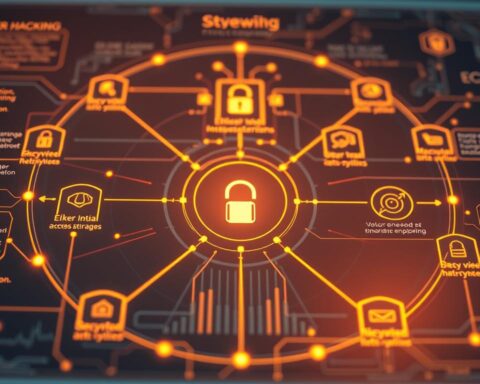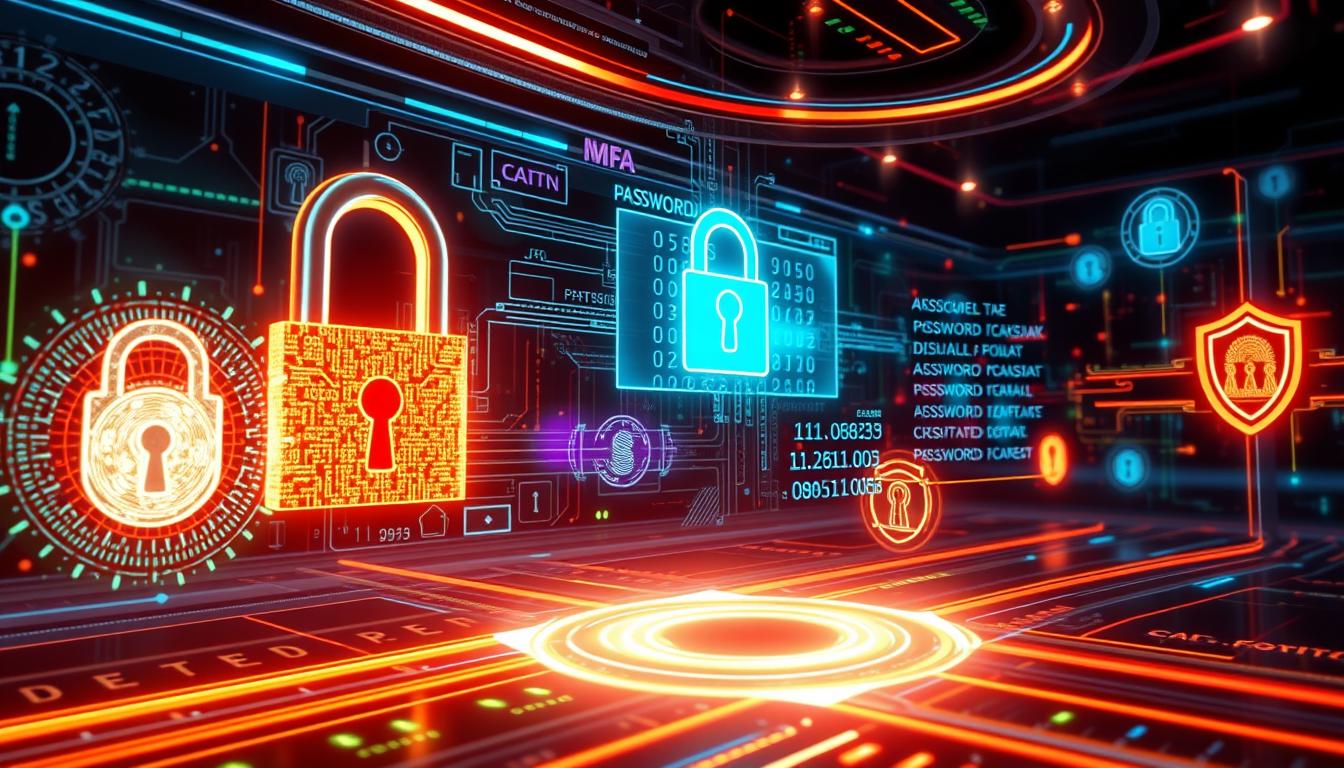Did you know that a Chief Information Security Officer (CISO) usually lasts only 18 months? This shows how fast cybersecurity leadership changes. It also highlights the need for a solid, lasting plan1. As we finish our 15-day cybersecurity training, we’ll put all we’ve learned into a plan for strong digital defense.
In today’s fast-changing world, a complete cybersecurity plan is essential. The Department of Homeland Security, one of the biggest federal departments, has stepped up its cybersecurity efforts2. This last day of training will give you the skills to make a cyber resilience plan that lasts.
We’ll show you how to mix new techniques with real-life examples. This way, your organization can handle the digital world with confidence. By combining everything, you’ll be ready to set up a lasting cybersecurity system. It will protect your important assets and keep up with new threats.
Key Takeaways
- Understand the importance of a holistic cybersecurity approach
- Learn to develop a complete cyber resilience strategy
- Integrate real-world scenarios into your security planning
- Explore the latest techniques in threat detection and response
- Create a roadmap for lasting cybersecurity implementation
- Align security measures with business objectives
- Prepare for continuous adaptation to evolving cyber threats
Understanding Modern Cybersecurity Landscape
The world of cybersecurity is changing fast in 2024. It needs a strong security plan to fight new threats. Almost 90 percent of data breaches happen because of weak security3.
Evolution of Cyber Threats in 2024
Cyber threats are getting smarter and causing more harm. The cost of a data breach hit $4.88 million in 2024, up 10 percent from last year3. AI attacks are getting better, making it hard to catch malware4.
Current Security Challenges
Companies face many cyber threats like malware, ransomware, and DDoS attacks3. Ransomware is now targeting small businesses because they have weaker defenses4. A new type of attack, ‘smart attacks,’ is also a big threat to many organizations4.
“Proactive threat management and continuous risk assessment are no longer optional – they’re essential for survival in the digital age.”
Impact of Global Digital Transformation
The fast move to cloud and remote work has changed the threat scene. 68% of companies expect more cyberattacks because of remote work5. This change means we need a strong cybersecurity plan where everyone helps defend against threats4.
| Cybersecurity Challenge | Impact | Mitigation Strategy |
|---|---|---|
| AI-powered attacks | Increased evasion of detection systems | Advanced AI-based defense mechanisms |
| Ransomware targeting SMEs | Financial and reputational damage | Robust backup systems and employee training |
| Remote work vulnerabilities | Expanded attack surface | Secure VPNs and endpoint protection |
As we face these challenges, the National Cybersecurity Strategy calls for teamwork between government and private sectors to fight cyber threats well.
Building a Comprehensive Security Framework
In today’s digital world, a strong security framework is essential. The NIST Cybersecurity Framework has five core functions: Identify, Protect, Detect, Respond, and Recover. It helps organizations of all sizes6. This framework boosts security and helps follow industry rules6.
Incident response planning is key in any framework. Cyberattacks jumped by 38% in 2022, hitting 422 million people. A good response plan can cut downtime during attacks76. It’s important to always check assets, weaknesses, and threats6.
Security automation is vital today. Tools like Security Information and Event Management (SIEM) help spot and act on security issues fast6. This is critical as threats keep rising in 20237.
Secure DevOps practices are also key. The manufacturing sector, hit hard by cyberattacks, must use access controls and cybersecurity training7. Keeping security plans up-to-date is vital to fight new threats6.
“A complete security framework isn’t just about tech – it’s about people, processes, and always getting better.”
To strengthen cybersecurity, focus on training employees, use firewalls and encryption, and test for weaknesses67. By combining these steps, companies can build a strong defense against cyber threats.
Bringing It All Together: Your Roadmap to Lasting Cybersecurity
Creating a strong cybersecurity strategy is key in today’s digital world. As threats grow, having a full integrated security framework is more important than ever. Let’s look at the main parts of a lasting cybersecurity plan.
Core Components of Cybersecurity Strategy
A good cybersecurity strategy has three main parts: people, processes, and technology. Companies need to focus on managing risks. By 2025, Chief Information Security Officers (CISOs) will work harder on this8.
Important parts include:
- Asset and vulnerability management
- Threat prioritization
- Incident response planning
- Employee training and awareness
The CISA’s FOCAL Plan in 2025 will focus on these areas. It aims to improve how fast we detect and fix threats8.
Implementation Timeline
Building a strong cybersecurity framework takes time. Here’s a suggested timeline:
| Phase | Duration | Focus Areas |
|---|---|---|
| Assessment | 1-2 months | Risk analysis, asset inventory |
| Planning | 2-3 months | Strategy development, policy creation |
| Implementation | 6-12 months | Tool deployment, process integration |
| Evaluation | Ongoing | Performance monitoring, continuous improvement |
Resource Allocation Guidelines
Getting the right resources is key for cybersecurity success. More companies are using a unified platform to save money and work better8. Here are some tips:
- Invest in cloud security operations, as demand for these skills is projected to grow significantly in 20258
- Allocate resources for ongoing education and training to adapt to new threats9
- Budget for certifications like CISSP, CISM, and CEH to boost team expertise9
By following this roadmap and staying alert, companies can build a strong cybersecurity defense against future threats.
Strengthening Information Sharing and Intelligence
The digital world needs strong information sharing and intelligence. Today, we must protect ourselves from cyber threats. Let’s look at how we can strengthen our defenses.
Public-Private Partnership Models
Public-private partnerships are key in cybersecurity. The U.S. is working with other countries to fight cyber threats together. This teamwork helps us manage threats better.
Threat Intelligence Integration
Integrating threat intelligence is important. The 2023 National Cybersecurity Strategy wants to work with other countries to keep the internet safe. This helps us find and stop threats faster.
Cross-Agency Collaboration
Working together across agencies is vital. The U.S. Department of State plans to help other countries with their digital security. This teamwork makes us stronger against cyber threats.
The COVID-19 pandemic made us move faster to cloud-based cybersecurity. CISA started an AI working group in March 2023. They aim to solve AI’s cybersecurity problems.
| Initiative | Purpose | Timeline |
|---|---|---|
| Digital Solidarity Building | Align national interests with international partners | Ongoing |
| International Digital Policy | Enhance cyber capacity | Next 3-5 years |
| AI Working Group | Address AI cybersecurity challenges | Established March 2023 |
By working together, we make our cybersecurity stronger. This teamwork helps us share information, use threat intelligence, and fight cyber threats better.
Advanced Screening and Vetting Processes
In today’s complex world, advanced screening and vetting are key to a strong cyber resilience strategy. The CIS Controls, released in May 2021, give a detailed plan for better security10. These controls help businesses focus on the most important threats, making their security stronger.
Using CIS Controls can greatly lower cyber risks, though the exact amount depends on the industry10. Companies that use these controls can create a solid security plan. This is very important, as seen in the recent big IT outage that hit airlines, media, and emergency services11.
The key to staying safe is to anticipate, withstand, recover, and adapt to cyber threats11. Advanced screening, along with constant monitoring and testing, are the core of a strong cybersecurity plan. Companies also need to follow many rules to avoid fines or audits11.
| Component | Description | Benefit |
|---|---|---|
| CIS Controls | Comprehensive security framework | Risk reduction and prioritization |
| Cyber Ranges | Simulated environments for testing | Safe deployment validation |
| AI and ML | Advanced threat detection | Enhanced real-time response |
To solve the cybersecurity talent gap, companies are using new methods like cyber ranges. These fake environments let teams test new security steps safely11. Also, AI and machine learning are key for spotting and fighting threats fast, making security even stronger11.
Implementing Proactive Threat Management
In today’s digital world, proactive threat management is key for businesses to keep up with cyber risks. With data breaches costing $4.45 million on average, strong cybersecurity is a must12.
Real-time Monitoring Solutions
Real-time monitoring is at the heart of good proactive threat management. These tools keep an eye on network activities, spotting threats fast. Advanced monitoring systems help businesses act quickly, cutting down risks.

Incident Detection Systems
Today’s incident detection systems use machine learning and analytics to spot threats accurately. They look at network traffic, user actions, and system logs for odd behavior. This is vital as cybercrime is driven by money for criminals12.
Response Automation
Security automation is key to fast threat response. Automated systems make incident response quicker, helping to stop threats fast. This is critical as more IoT devices add to the attack surface in areas like healthcare12.
Good cybersecurity needs teamwork, with clear roles and responsibilities for better risk management13.
Businesses should check their cybersecurity level using tools like the NIST Cybersecurity Framework. This helps find areas to improve in their threat management strategy13.
| Component | Function | Benefit |
|---|---|---|
| Real-time Monitoring | Continuous network visibility | Early threat detection |
| Incident Detection | Pattern analysis and anomaly identification | Reduced false positives |
| Response Automation | Streamlined incident response | Faster threat containment |
By combining these elements, businesses can move from reacting to threats to actively managing them. This not only boosts security but also supports growth and innovation, making cybersecurity a key business driver1213.
Developing Cyber Resilience Strategies
In today’s digital world, having a strong cyber resilience strategy is key for companies. A huge 96% of CEOs see cybersecurity as vital for growth and stability14. This shows the need for a complete cybersecurity plan that does more than just defend.
A good cyber resilience plan includes always checking for risks and taking steps ahead of time. Companies need to know what’s most important, where they might be weak, and how to keep going if hit by cyber attacks. With data breaches costing an average of $4.88 million, being ready is a must14.
- Business continuity planning
- Disaster recovery procedures
- Crisis management protocols
- Regular testing and refinement
Using the Australian Cyber Security Centre’s “Essential Eight” can really help cut down on risks. These include things like controlling apps, using more than one way to log in, and making sure apps are safe15.
Also, managing data well is important. Things like controlling who can see what and using encryption to keep data safe are key. Checking who has access and how data is handled regularly also helps a lot15.
“Cyber resilience is not just about prevention; it’s about maintaining operations and swiftly recovering from incidents.”
By having a full cyber resilience plan, companies can keep data safe, reduce downtime, and keep customers happy. This way, they can get back to normal fast and do better than others14.
| Strategy Component | Benefit |
|---|---|
| Continuous Risk Assessment | Proactive Threat Identification |
| Business Continuity Planning | Minimal Operational Disruption |
| Regular Testing | Improved Incident Response |
| Employee Training | Enhanced Organizational Resilience |
Remember, cyber resilience is always a work in progress. Keeping up with new threats and training employees is key15. By doing these things, companies can build a solid base for lasting security.
Establishing Security Operations Centers
Security Operations Centers (SOCs) are key to a strong security framework. They are vital for managing threats and planning for incidents. With 83% of companies facing data breaches in 202316, SOCs are more important than ever.
24/7 Monitoring Capabilities
Constant watchfulness is critical for good cybersecurity. A small to medium business needs at least one manager, an engineer, and five security analysts working 24/716. This team ensures threats are caught and dealt with quickly.
Incident Response Teams
SOCs have a team structure for different security tasks. Tier 1 analysts check alerts, Tier 2 respond, and Tier 3 hunt for threats16. This setup helps handle incidents well and stop threats.
Technology Integration
Modern SOCs use various technologies to improve their work:
- EDR solutions for real-time data from devices
- SIEM tools for managing logs and meeting rules16
- SOAR platforms for automated workflows and reports16
These tools are the backbone of a good SOC. They help find and act on threats fast. Adding these technologies and training staff should be part of the SOC budget16.
| SOC Component | Function | Impact |
|---|---|---|
| 24/7 Monitoring | Continuous threat surveillance | Rapid threat detection |
| Tiered Analyst Structure | Specialized threat handling | Efficient incident response |
| Integrated Technologies | Automated threat management | Enhanced security posture |
With a well-built SOC, skilled people, and the right tech, companies can boost their security. They can also handle threats better as they come.
Creating Complete Training Programs
In today’s digital world, it’s key for companies to have strong cybersecurity training. The World Economic Forum’s Global Risks Report 2020 said cyber-attacks are a top global risk. This shows how important it is to train employees well to avoid mistakes17.
Creating a training plan that meets everyone’s needs is important. Everyone in the company, from tech staff to top leaders, needs to learn about cybersecurity. Hands-on training and real-life scenarios help people learn and remember better.
New ways like gamification and virtual reality make learning fun and effective. For example, the LDR514 course uses a game to teach leadership in cybersecurity. This method fits well with the idea of covering all security needs in a company18.
It’s also important to keep training going and offer certifications. With over 343 million victims of cyberattacks in 2023, keeping skills sharp is a must19. Companies should look for training that helps staff understand and meet customer needs, making the business stronger18.
| Training Component | Description | Impact |
|---|---|---|
| Scenario-based Training | Real-world simulations | Improved problem-solving skills |
| Gamification | Interactive learning experiences | Increased engagement and retention |
| Certification Paths | Structured skill development | Enhanced professional growth |
| Leadership Development | Strategic security planning | Improved organizational synergy |
By using these detailed training plans, companies can make their teams more aware of security. Remember, good training can really cut down on mistakes in cybersecurity19.
Integrating Security Automation and DevOps
Today, companies are using security automation and DevOps to strengthen their defenses. This method, known as an integrated security framework, changes how businesses protect themselves and work more efficiently.
Automated Security Testing
Automated security testing is key in modern cybersecurity. It finds vulnerabilities early, preventing expensive breaches. Many say it makes them better at finding and fixing threats, with 75% spending as much time on false alarms as real ones20.
Continuous Integration/Deployment
CI/CD pipelines are vital for secure DevOps. They automate building, testing, and deploying software, keeping security consistent. Yet, 64% of Security Operations Center teams find it hard to switch between tools20.
Security Pipeline Implementation
Building a solid security pipeline is key to a strong defense. It involves adding security checks at every development and operation stage. But, many struggle to set it up. 71% of info security pros feel burned out, with 62% blaming too much manual work20.
To overcome these issues, companies are investing in better automation and training. They want to cut down on manual tasks and boost security. As technology advances, combining security automation and DevOps will keep shaping the future of cybersecurity.
Measuring Security Effectiveness
In today’s fast-changing cybersecurity world, it’s key to check how well security works. Cyber attacks are rising, with a 7% jump in weekly attacks worldwide in Q1 2023. Each week, on average, organizations face 1,248 cyber attacks21.
Keeping a close eye on risks is at the heart of good cybersecurity. Yet, 73% of IT pros know less than 80% of their assets. This makes it hard to fully assess risks21. It shows the need for strong asset management in threat management.
Key Performance Indicators for Security Effectiveness
To see how well security works, focus on certain metrics:
- Time to Respond: Shows how fast teams can handle incidents
- False Positive Reporting Rate: Checks if threat detection is accurate
- Risk Heat Mapping: Shows where risks are high in IT systems
- Benchmarking: Compares security to industry standards22
These metrics give real data to improve security. Regular checks help spot new risks and check if controls work22.
Using a risk-based approach helps businesses see if their security spending is worth it. This method links security efforts to business goals, making it easier to explain security spending to others22.
Security breaches can cost a lot. Human mistakes alone can lead to breaches costing $3.33 million on average21. This highlights the need for good security awareness and training new employees on security policies22.
| Security Metric | Purpose | Impact |
|---|---|---|
| Time to Respond | Measure incident response speed | Reduces damage from attacks |
| False Positive Rate | Check threat detection accuracy | Improves how resources are used |
| Risk Heat Mapping | Show where risks are high | Helps focus security efforts |
| Industry Benchmarking | Compare security practices | Finds areas for improvement |
By focusing on these areas and staying proactive, organizations can improve their cybersecurity. This helps protect their digital assets in a complex threat world.
Conclusion
Our journey to lasting cybersecurity is essential in today’s digital world. Cybercrime is expected to cost the world $10.5 trillion by 2025, growing 15% each year23. This shows we need a strong, all-around approach to protect ourselves.
We’ve gained important knowledge along the way. We’ve seen how 93% of CISOs use artificial intelligence to fight cyber threats24. But, we also face big challenges. 95% of companies worry about not having enough skilled people, and 91% feel they’re not ready for cyberattacks24.
We must take action. Only 54% of big companies have a disaster recovery plan, and 77% lack a formal incident response plan25. Remember, cybersecurity is a continuous journey. Stay alert, keep learning, and use new technologies to protect us. Your journey to lasting cybersecurity begins now. Use it to navigate the digital world with confidence and strength.
FAQ
What are the key components of a complete cybersecurity strategy?
A solid cybersecurity strategy has three main parts: people, processes, and technology. It includes risk assessment, incident response planning, and security automation. It also covers secure DevOps practices, continuous monitoring, and employee training.
The strategy should also have proactive threat management and a cyber resilience plan. This ensures the organization can adapt to new threats.
How can organizations effectively implement a cybersecurity roadmap?
To implement a cybersecurity roadmap, follow these steps: 1) Do a thorough risk assessment. 2) Focus on the most critical assets and vulnerabilities. 3) Create a timeline for implementation.
4) Make sure you have the right resources. 5) Use security automation and DevOps practices. 6) Set up a Security Operations Center (SOC). 7) Keep monitoring and improving security. 8) Train employees to be security-aware.
What role does threat intelligence play in modern cybersecurity?
Threat intelligence is key in modern cybersecurity. It gives real-time insights into threats. This helps in proactive threat management and risk assessment.
It also improves incident response planning. By integrating threat intelligence, organizations can stay ahead of threats and adapt their defenses.
How can organizations measure the effectiveness of their cybersecurity program?
To measure cybersecurity effectiveness, use several methods: 1) Set up key performance indicators (KPIs) and security metrics. 2) Do regular security assessments with frameworks like NIST or ISO 27001.
3) Perform penetration testing and red team exercises. 4) Use threat intelligence for risk quantification. 5) Keep monitoring security continuously. 6) Track how fast incidents are resolved.
What are the benefits of integrating security automation and DevOps practices?
Integrating security automation and DevOps, or SecDevOps, has many benefits. It improves security by detecting vulnerabilities early. It also makes development and deployment faster and more efficient.
It ensures security controls are applied consistently. It reduces human error and improves incident response times. It also aligns security, development, and operations teams better.
How can organizations develop effective cyber resilience strategies?
To develop effective cyber resilience strategies, follow these steps: 1) Do a thorough risk assessment. 2) Identify critical assets and vulnerabilities. 3) Have robust business continuity and disaster recovery plans.
4) Build redundancy and fault tolerance into systems. 5) Regularly test and refine plans through exercises and simulations. 6) Foster a culture of adaptability and continuous improvement.
Source Links
- The First 90 Days as CISO- Your Roadmap to Success – https://xmcyber.com/90-days-as-ciso/
- DHS Strengthened and Innovated, Leveraged New Partnerships, and Invested in the Workforce to Tackle Today’s Threats | Homeland Security – https://www.dhs.gov/news/2025/01/17/dhs-strengthened-and-innovated-leveraged-new-partnerships-and-invested-workforce
- What is Cybersecurity Posture? Key Steps and Insights – https://www.sentinelone.com/cybersecurity-101/cybersecurity/cybersecurity-posture/
- Are We Prepared? – https://medium.com/@antonio.radu/are-we-prepared-the-cybersecurity-landscape-is-shifting-and-2024-will-bring-new-challenges-5982602da4a5
- Understand Modern Cybersecurity Solutions for Manufa… – https://www.infotech.com/research/ss/understand-modern-cybersecurity-solutions-for-manufacturing-it-ot
- NIST Framework: Your Roadmap to a Bulletproof Cybersecurity – https://www.envision-consulting.com/nist-framework-your-roadmap-to-a-bulletproof-cybersecurity-strategy/
- Ultimate Guide: How to Create a Cybersecurity Roadmap – https://www.launchconsulting.com/how-to-guide-to-cybersecurity-hygiene
- Cybersecurity 2025: Qualys’ Predictions for Navigating the Evolving Threat Landscape | Qualys Security Blog – https://blog.qualys.com/qualys-insights/2025/01/16/cybersecurity-2025-qualys-predictions-for-navigating-the-evolving-threat-landscape
- What roadmap do I need to become good and get a job in cyber security – https://www.careervillage.org/questions/917035/what-roadmap-do-i-need-to-become-good-and-get-a-job-in-cyber-security
- SEC566: Implementing and Auditing CIS Controls™ – https://www.sans.org/cyber-security-courses/implementing-auditing-cis-controls/
- Resilience Through Collaboration: A Unified Cybersecurity Strategy – https://www.wwt.com/article/resilience-through-collaboration-a-unified-cybersecurity-strategy
- Building a Proactive and Adaptive Cybersecurity Strategy: Insights for Enterprise Success – https://www.optiv.com/insights/discover/blog/build-a-cybersecurity-strategy
- Step-by-Step Cybersecurity Strategy Implementation Plan for Businesses – https://www.ecsoffice.com/cybersecurity-strategy-implementation-plan/
- What is Cyber Resilience? Benefits & Challenges – https://www.sentinelone.com/cybersecurity-101/threat-intelligence/cyber-resilience/
- How to Build A Solid Cyber Security Strategy in 5 Steps – https://www.stanfieldit.com/cyber-security-strategy/
- Steps to Building a Security Operations Center – https://underdefense.com/blog/4-steps-to-building-a-security-operations-center/
- 3 Tips To Build A Cyber Resilience Roadmap – https://www.metricstream.com/learn/3-tips-to-build-cyber-resilience.html
- LDR514: Security Strategic Planning, Policy, and Leadership™ – https://www.sans.org/cyber-security-courses/strategic-security-planning-policy-leadership/
- Building A Cybersecurity Strategy For Growing Businesses | Attentus Technologies – https://www.attentus.tech/cyber-security/building-cybersecurity-strategy-for-growing-business
- Build an Automation Roadmap to Streamline Security P… – https://www.infotech.com/research/ss/build-an-automation-roadmap-to-streamline-security-processes
- 8 Ways to Improve Your Security Posture & How You Assess It – https://secureframe.com/blog/security-posture
- How to Measure the Effectiveness of Security Programs? – https://www.infosecurity-magazine.com/opinions/how-measure-effectiveness-security/
- Understand the Importance of Cyber Security: Guardian Against Threats! – https://www.simplilearn.com/tutorials/cyber-security-tutorial/what-is-cyber-security
- Build an Autonomous Security Delivery Roadmap – https://www.infotech.com/research/ss/build-an-autonomous-security-delivery-roadmap
- Your Roadmap to Recovery: Effective Steps to Recover From a Cyber Attack – https://bryghtpath.com/steps-to-recover-from-a-cyber-attack/










